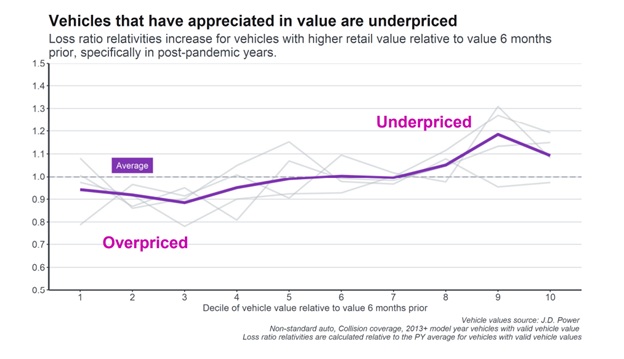Simplifying Risk Analysis with VIN Data

By Jim Vecchio, Head of VIN Products, Autodata Division, J.D. Power —
The insurance industry needs dynamic auto pricing symbols.
At the 2024 Casualty Actuarial Society’s (CAS) Ratemaking, Product & Modeling (RPM) seminar last month, I had the opportunity to join Martin Ellingsworth from Salt Creek Analytics and Liam McGrath and Clayton Spinner from WTW for a panel discussion around how insurance carriers can simplify their risk analysis using VIN-specific, as-built data.
VIN level data has been used in ratemaking for decades. As vehicles get less homogeneous at the make and model level, there is more opportunity to add precision to rating not just using the first 8 digits of the VIN, but the entire 17-digit VIN. Our session dove into the ways auto insurers look at vehicle data and confronted some of the challenges associated with using a one-size-fits-all approach. We also explored examples using insurance loss data to show how using changes in used car prices can enhance pricing algorithms.
For those who were unable to catch our panel, below is a recap of our discussion.
Martin cautioned insurers to be ready to explain why the same base rate increases were being applied across the board despite every car having different safety features and a different actual cash value.
Liam explored the impact of rising vehicle values on pricing, explaining that the average used retail value for insured vehicles jumped after the initial pandemic shock. While changes in vehicle value, and more specifically vehicle depreciation, have historically been consistent across vehicles, he revealed that vehicle value changes have become more varied since the pandemic and that vehicles that have appreciated in value are being underpriced. He further discussed the impact of using real time vehicle value as an additional tool for segmentation and incorporating dynamic vehicle value into the pricing process.
I then dove into the topic of simplifying risk analysis with VIN-specific, as-built data and explored the following five themes:
1. The differences between Base MSRP and As-Built MSRP can be significant.
2. More complex vehicle technology is making it more challenging to accurately and competitively price insurance policies.
3. Inflation has made traditional vehicle depreciation curves obsolete.
4. Traditional VIN decoding does not provide sufficient detail to identify individual vehicles’ precise value, resulting in imprecise values, costly oversights and ultimately missed opportunities.
5. Insurance carriers need valuations based on actual OEM build data and vehicle configuration information to reveal exact vehicle specifications.
Bottom Line: The insurance industry needs dynamic auto pricing symbols.
If you’re looking to take the guesswork out of obtaining accurate vehicle valuations and eliminate manual processes and missed opportunities, let’s connect.
Read the original post with additional charts and graphics.
About the Author
Jim Vecchio is the Head of VIN Products for the Autodata Solutions Division of J.D. Power. Jim is a seasoned entrepreneurial executive who is focused on fueling data solutions across J.D. Power. Connect with Jim on LinkedIn.
For more insights like this, sign up for the Insurance Insights monthly newsletter from J.D. Power.
About J.D. Power
J.D. Power is a global leader in consumer insights, advisory services and data and analytics. A pioneer in the use of big data, artificial intelligence (AI) and algorithmic modeling capabilities to understand consumer behavior, J.D. Power has been delivering incisive industry intelligence on customer interactions with brands and products for more than 50 years. The world’s leading businesses across major industries rely on J.D. Power to guide their customer-facing strategies.
J.D. Power is headquartered in Troy, Mich., and has offices in North America, Europe, and Asia Pacific. To learn more about the company’s business offerings, visit JDPower.com/business. The J.D. Power auto shopping tool can be found at JDPower.com.
SOURCE: J.D. Power







